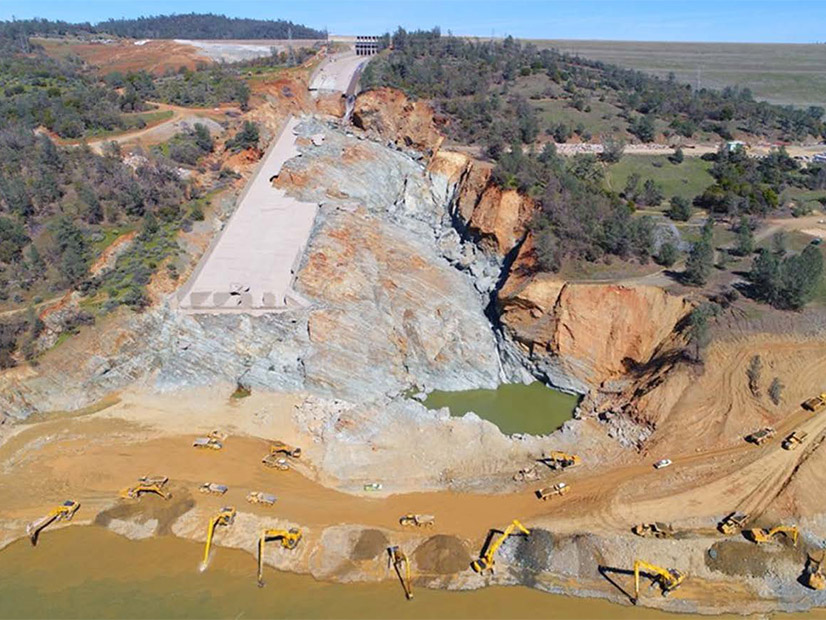FERC on Thursday approved a rule to improve hydro dam safety by instituting a two-tier inspection program and requiring such inspections to be performed by teams with site-specific expertise, rather than a single independent consultant.
Additional provisions in the rule (RM20-9-000) will also codify a 2012 requirement that dam owners develop and file with FERC a Dam Safety Program, as well as report any public safety incidents, including rescues, related to project operations. The rule passed unanimously, with newly installed Commissioner Willie Phillips not voting. It will take effect 90 days after publication in the Federal Register.
The new requirements are based on recommendations from an analysis of the February 2017 incident in which California’s Oroville Dam, the tallest dam in the nation, saw major damage to its primary spillway and the first activation of its auxiliary spillway. About 180,000 people were forced to evacuate the surrounding area. Emergency response and repairs cost more than $1.1 billion, said a recent report from the Congressional Research Service.
Citing that report, FERC Chair Richard Glick said that the U.S. has 90,000 dams, 15% of which are classified as “high hazard potential,” meaning that any failure of the dam could result in loss of life. In addition, half the dams are more than 50 years old and could require upgrades costing an estimated $20 billion, Glick said.
FERC has jurisdiction over more than 2,500 hydro projects, said a Hydropower Primer the commission released in 2017. Following the Oroville incident, FERC convened its own review panel to suggest potential changes to its Dam Safety Program. A notice of proposed rulemaking (RM20-9) was issued in July 2020. (See FERC Proposes Tougher Hydro Safety Rules.)
David Capka, director of the Division of Dam Safety and Inspections in the Office of Energy Projects, said the final rule contains some “clarifying edits” made in response to comments received from stakeholders, including dam owners, other federal agencies and trade associations. But otherwise, it is essentially the same as the 2020 NOPR, he said.
Two-tier System
Prior to the vote, Tara DiJohn, attorney-advisor in FERC’s Office of General Counsel, provided more detail on the four “overarching objectives” of the rule.
All hydro projects under FERC’s jurisdiction will still be subject to the commission’s inspection rules, as spelled out in regulations known as Part 12D, which require inspections every five years. But, DiJohn said, under the two-tier system, “the required scope of the inspection will alternate between a periodic inspection and a comprehensive inspection.”

Periodic inspections will focus on “the performance of the project over the previous five years,” she said. “It includes a field inspection or review of project operations, an in-depth review of monitoring data trends and behavior, and an evaluation of whether any potential failure modes are occurring.”
Comprehensive assessments will build on the periodic reviews “with a deep dive into every aspect of a project, including a detailed review of the design basis, analysis of records and construction history, and evaluation of spillway adequacy [and] potential failure modes analysis and risk analysis,” she said.
Commissioner Allison Clements raised concerns about the cost of the new inspections. “If we’re going to strengthen safety, we have to balance the benefits of more stringent requirements with the cost burden to the regulated [projects], including the smaller entities that may have fewer resources,” she said.
The two-tier system is intended to help offset the cost of inspections, DiJohn said, with the periodic inspections being “less burdensome.” With smaller, less complex projects, licensees can also propose a single independent consultant to perform the inspection, she said.
First Line of Defense
The second major provision modifies who performs the Part 12D inspections. “Instead of focusing on the individual independent consultants, we will focus on the qualifications of the independent consultant teams,” DiJohn said.
“We have a lot of very large and very complex projects, and requiring one person to be responsible to review all the features of those projects is a lot to ask,” she said. “To have the right expertise, we want to ensure that licensees look at teams to do that.”
While first required in 2012, the Dam Safety Programs codified in the new rule will “formalize licensees’ policies and procedures related to organizational oversight and responsibilities, internal communication, resource allocation and continuous improvement,” DiJohn said. “A proactive, conscientious licensee is the first line of defense against potential dam safety issues.”
Finally, the rule expands requirements for reporting on public safety incidents at or near dams, DiJohn said, adding rescues to the list of incidents to be reported, along with serious injuries and deaths.
Calling dam safety “one of our most important jobs,” Glick said the new rule was “a step in the right direction … [but] not the end of our efforts to protect the public.” The commission is planning a staff-led technical conference, possibly in April, Glick said, examining financial assurance measures for hydropower projects to ensure than licensees have sufficient financial resources for dam maintenance and repair as needed for public safety.




